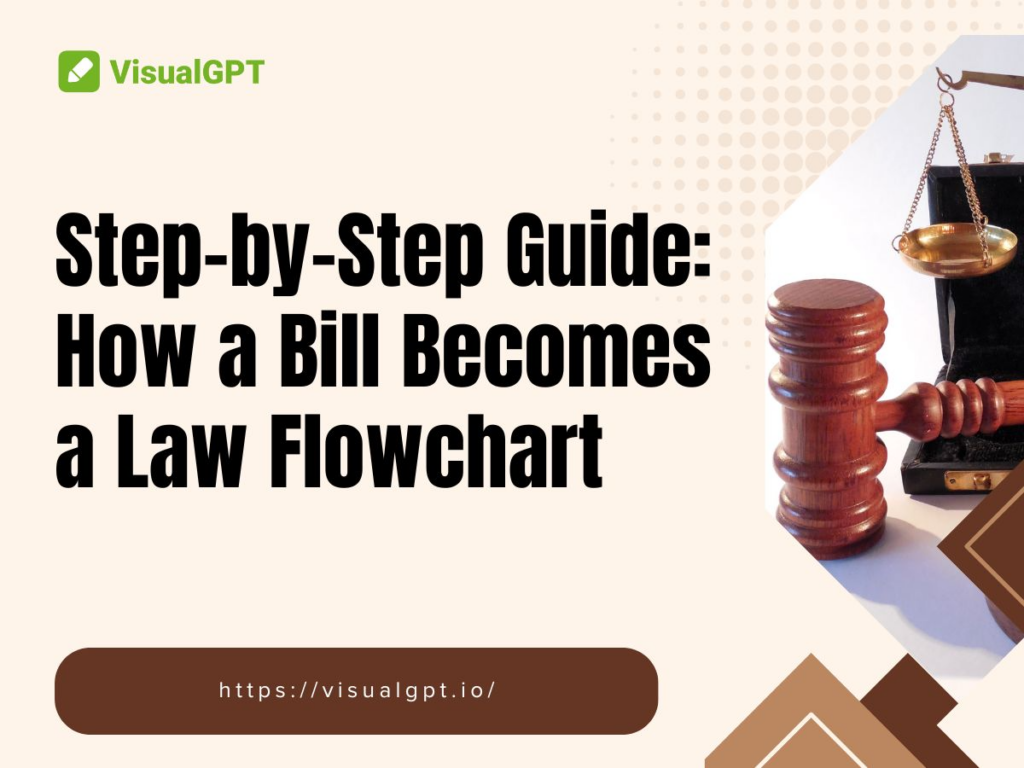Introduction to the U.S. Legislative Process
Why Understanding How a Bill Becomes a Law Matters
Laws shape the way we live, work, and interact every day. From traffic rules to education policies, every law in the United States starts the same way — as a bill. Understanding this process is not just for politicians or lawyers. It’s for you, your community, and anyone who wants to see change happen.
But here’s the thing: the U.S. legislative process can feel overwhelming if you’re only reading dense legal text. There are committees, votes, amendments, and presidential decisions — and each step has its own rules. If you’ve ever felt confused about how a bill turns into an official law, you’re not alone.
That’s why using a how a bill becomes a law flowchart can be a game changer. Instead of pages of text, you get a clear picture of each step from start to finish. It’s like having a map for the legislative journey.
How a Bill Becomes a Law Flowchart as a Learning Tool
A flowchart doesn’t just look nice — it simplifies something that’s otherwise complex. Each box represents a step. Each arrow shows the direction the bill moves. And if the bill hits a roadblock, the chart shows you where it goes next. By following a how a bill becomes a law flowchart, you can quickly see the “big picture” without getting lost in the details.
The Basic Steps of How a Bill Becomes a Law
From Proposal to Committee Review
It all starts with an idea. Maybe it comes from a citizen, a group, or a member of Congress. That idea becomes a bill when a senator or representative writes it down and introduces it to Congress.
Once introduced, the bill heads to a committee. This group studies the bill, holds hearings, and decides whether it should move forward. Committees can approve, change, or reject bills. If the committee says yes, the bill goes to the next step.
Debates, Voting, and Amendments
Next, the bill is debated in either the House of Representatives or the Senate, depending on where it started. Members discuss the bill’s pros and cons, suggest changes (called amendments), and then vote. If it passes one chamber, it goes to the other.
This back-and-forth can take time. Sometimes the House and Senate pass slightly different versions. In that case, a conference committee works out the differences before sending it back for a final vote.
Presidential Approval or Veto
Once both chambers agree, the bill goes to the President. The President can:
- Sign it into law.
- Veto it (reject it).
- Do nothing — in which case the bill can still become law after 10 days if Congress is in session.
If the President vetoes the bill, Congress can override the veto with a two-thirds vote in both chambers.
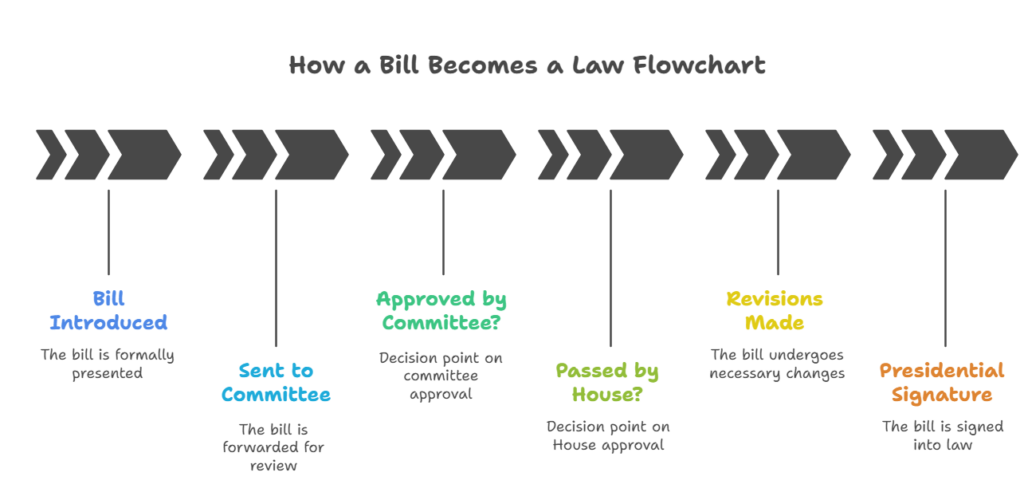
Why Use a How a Bill Becomes a Law Flowchart
Advantages of Visual Learning Over Text
A written explanation can be helpful, but your brain processes images far more quickly than it processes paragraphs of text. That’s where a how a bill becomes a law flowchart comes in. It turns a long, complex government process into a visual roadmap you can follow at a glance. Instead of flipping back and forth between sections of a textbook, you can trace the arrows and instantly see what happens next.
Think about how you might learn a new board game. You could read a 10-page instruction manual, or you could look at a diagram showing how each move works. The same principle applies here — the how a bill becomes a law flowchart acts like that diagram, making the legislative process easier to grasp. Each arrow acts as a clear “next step” signal, so you always know where the bill is headed.
For example, instead of spending minutes reading a paragraph about how a bill moves from a committee to the Senate floor, you can glance at one arrow connecting two boxes. You instantly see the relationship between steps without having to memorize every detail. This saves time and reduces frustration, especially for students or anyone new to how Congress operates.
Simplifying Complex Legal Processes
Government procedures can feel intimidating, especially when they involve multiple decision points, committees, and potential roadblocks. A how a bill becomes a law flowchart breaks that complexity into bite-sized actions. Each step is represented by a simple shape, and each decision point is clearly labeled, so you never lose track of the bill’s progress.
Even if you’ve never taken a civics class, you can still follow the process from idea to final signature just by tracing the chart. This visual breakdown is especially valuable for teachers explaining the legislative process, community organizers helping people understand how change happens, or even individuals following a bill they care about in real time.
And when paired with a digital tool like VisualGPT or its AI Flowchart Generator, you can make the how a bill becomes a law flowchart even more interactive. You could highlight certain steps, add color-coded notes for key decisions, or link to real-world examples of bills at each stage. That way, the chart doesn’t just explain the process — it becomes a living, educational resource.
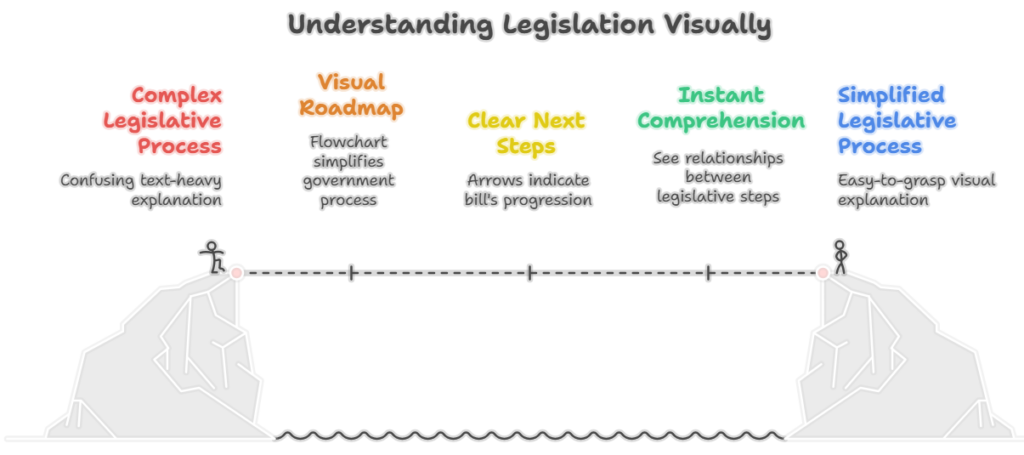
How to Read a Bill to Law Flowchart
Key Symbols and Process Arrows
Understanding the symbols and arrows is the first step to reading any how a bill becomes a law flowchart effectively. Flowcharts follow a visual logic: rectangles usually indicate actions, like “Bill Introduced” or “Sent to Committee,” while diamonds represent decision points, such as “Approved by Committee?” or “Passed by House?” These diamonds often have arrows pointing to “Yes” or “No” outcomes, showing different paths the bill can take.
Arrows are crucial. They guide your eyes through the process and indicate the direction of the bill’s journey. Some flowcharts use solid arrows for standard steps and dashed arrows for alternative or optional paths. For instance, a bill that fails a vote might loop back via a dashed arrow to a “Revisions Made” box, demonstrating that even rejected bills can return for another attempt.
Using a how a bill becomes a law flowchart makes these connections immediately obvious. You don’t have to read lengthy paragraphs describing committee reviews or voting outcomes — the visual cues tell the story. To make it even clearer, tools like VisualGPT and its AI Flowchart Generator allow you to color-code steps, highlight critical decisions, and add icons that indicate important milestones, like a gavel for committee approval or a pen for presidential signature. This visual layering helps both students and professionals grasp complex legislative procedures faster.
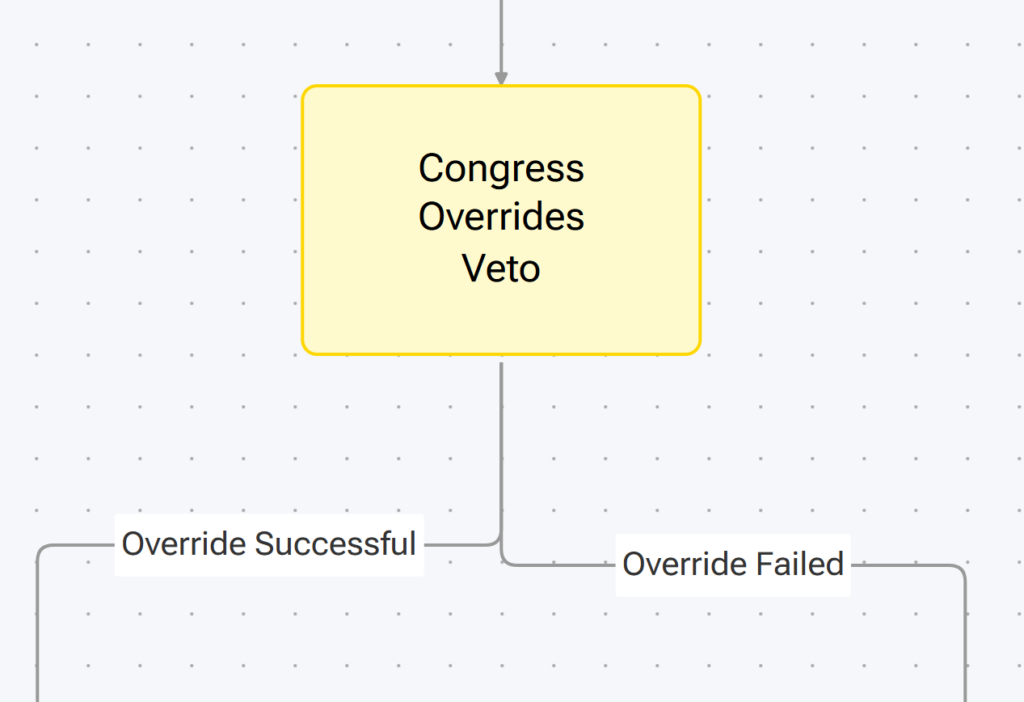
Tracing the Legislative Path Step-by-Step
When following a how a bill becomes a law flowchart, start at the top or left side of the chart. Each arrow you trace shows the movement of the bill from introduction to final approval. As you move through the chart, you can immediately see where a bill might pause, encounter challenges, or be redirected for revisions.
Consider a real-world example: a proposed education reform bill. By following the flowchart, you can see it pass through initial committee review, then move to debate in the House. If it fails a vote there, the arrow leads back to the committee for modifications. This visual path makes it easy to understand the bill’s lifecycle — something that would take several pages of text to explain clearly.
How a Bill Becomes a Law Flowchart Example
Full Visual Representation of the Process
Seeing the entire legislative process in one visual is one of the biggest advantages of a how a bill becomes a law flowchart. This type of flowchart allows you to view every major step at a glance, from the bill’s introduction to its final approval or rejection. Unlike reading multiple pages of text, the flowchart gives a clear, organized roadmap that anyone can follow.
Here’s a typical breakdown of the steps included in a how a bill becomes a law flowchart:
- Bill Introduction – Every law starts as an idea. This could come from citizens, advocacy groups, or members of Congress. In the flowchart, the introduction is usually represented by a rectangle at the top, signaling the official start of the process.
- Committee Review – After introduction, the bill is sent to a relevant committee. The committee studies it, holds hearings, and may suggest amendments. If the bill passes the committee stage, it moves forward; if not, it may be revised or shelved. In a how a bill becomes a law flowchart, this stage is clearly labeled and often connected with arrows showing both approval and rejection paths, making the potential outcomes easy to visualize.
- Floor Debate and Voting in Both Chambers – Once approved by the committee, the bill goes to the full House or Senate for debate. Lawmakers discuss, amend, and vote on the bill. If it passes one chamber, it moves to the other. The flowchart shows parallel paths for each chamber, making it simple to see how a bill navigates both legislative bodies. This visual approach helps anyone understand the step-by-step progression without needing to read dense legislative reports.
- Resolution of Differences – If the House and Senate pass slightly different versions of the bill, a conference committee works out the differences. This step is often highlighted in a how a bill becomes a law flowchart with a decision diamond or connecting arrows, clearly showing that reconciliation is necessary before the bill can proceed.
- Presidential Decision – Finally, the bill reaches the President, who can sign it into law, veto it, or do nothing (allowing it to become law automatically after a set period). A good how a bill becomes a law flowchart includes these options and shows the paths for potential veto overrides by Congress, ensuring the viewer understands all possible outcomes.
The how a bill becomes a law flowchart shows these steps visually, making it easy to explain to students, colleagues, or anyone curious about the process.
Downloadable and Printable Versions
If you want your own copy, you can download or print it to keep as a reference. It’s perfect for classrooms, study groups, or civic engagement workshops.
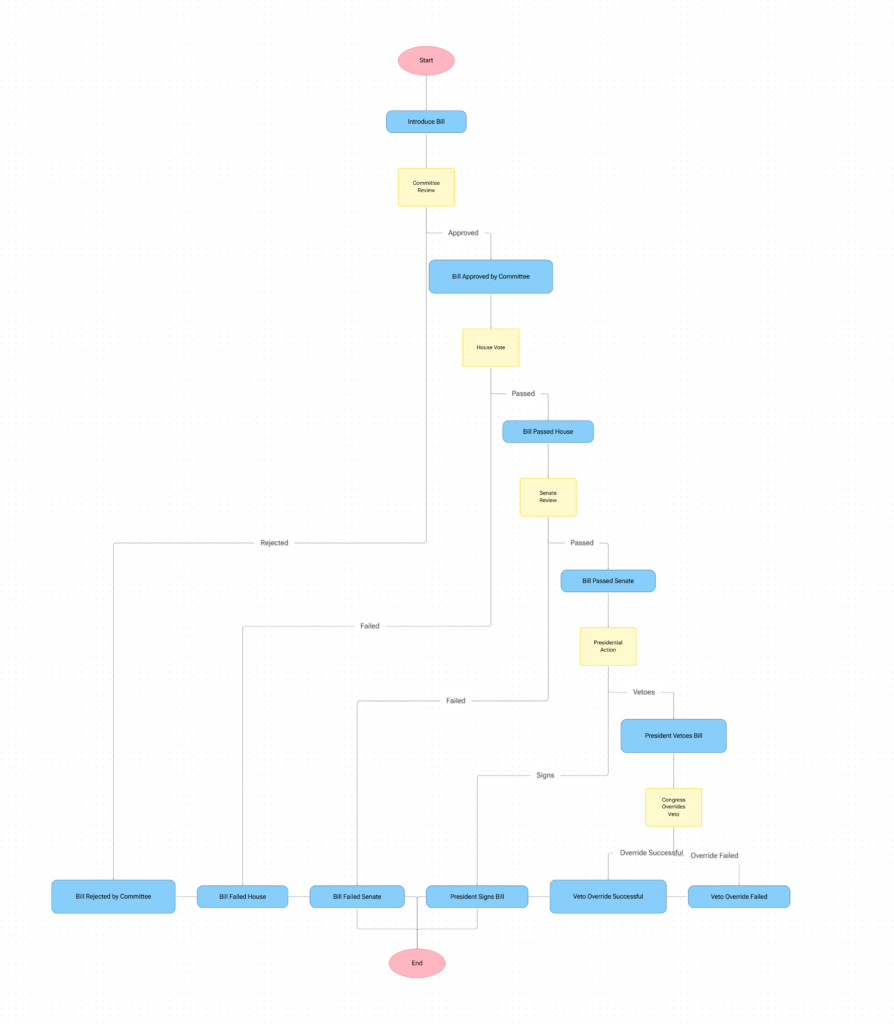
Using Online AI Flowchart Tools for Legislative Processes
Benefits of AI-Generated How a Bill Becomes a Law Flowcharts
Manually creating a detailed flowchart can be time-consuming. This is where VisualGPT shines. With its AI Flowchart Generator, you can produce professional, clear charts in minutes.
Some benefits include:
- Automatic design and layout.
- Editable text and shapes for customization.
- High-resolution exports for print or presentation.
Whether you’re a teacher, student, or community organizer, using an AI tool like VisualGPT means you spend less time formatting and more time teaching or learning.
Step-by-Step Guide to Creating Your Own Flowchart
Step 1 : Go to AI Flowchart Generator.
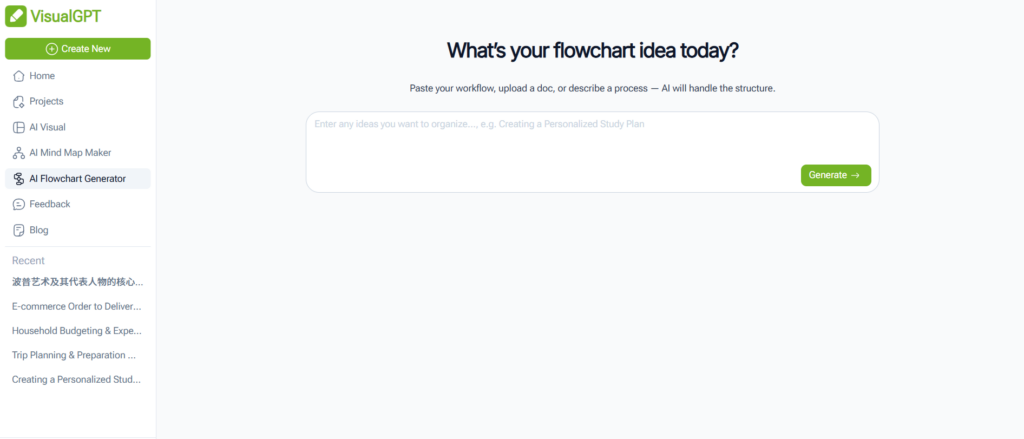
Step 2 : Type in your process — in this case, the U.S. bill-to-law steps.

Step 3 : Let VisualGPT automatically generate a clean, logical how a bill becomes a law flowchart.
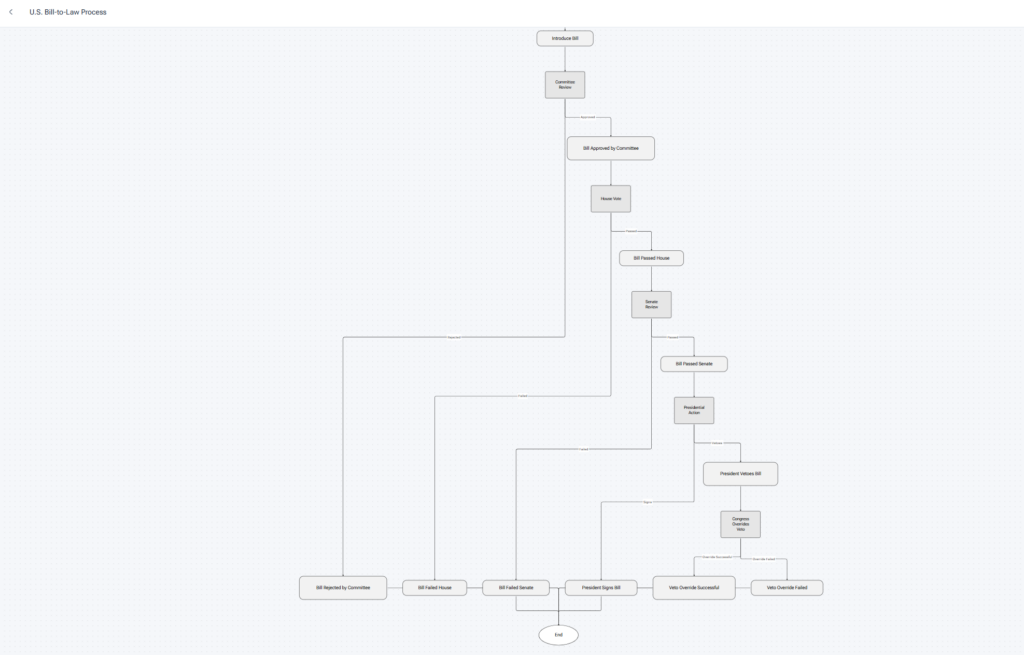
Step 4 : Customize colors, labels, and icons to match your audience.
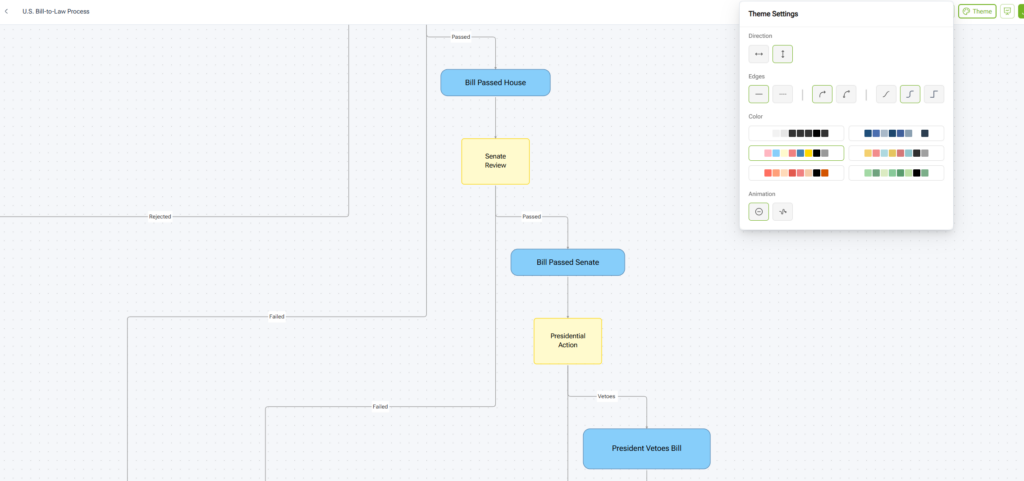
Step 5 : Download your chart and share it digitally or in print.
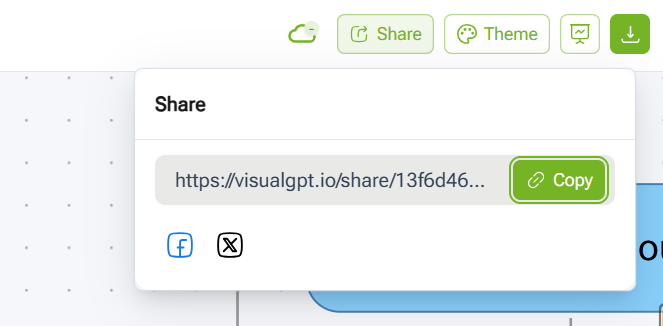
Additional Resources and Related Reading
U.S. Government Educational Links
If you want official explanations, visit:
1. congress.gov for real-time bill tracking.
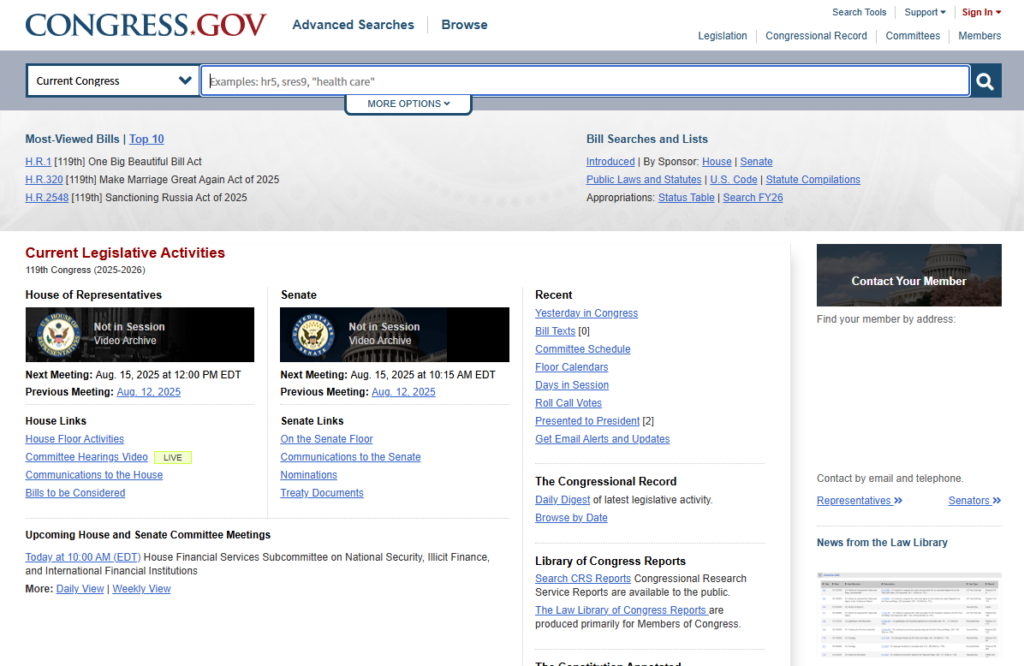
2. usa.gov for government structure basics.
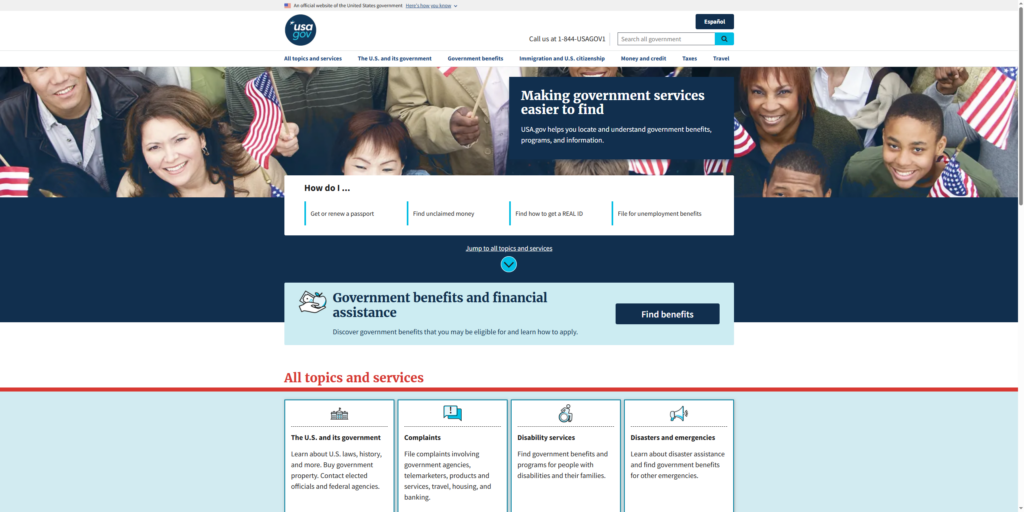
3. whitehouse.gov for presidential actions on bills.
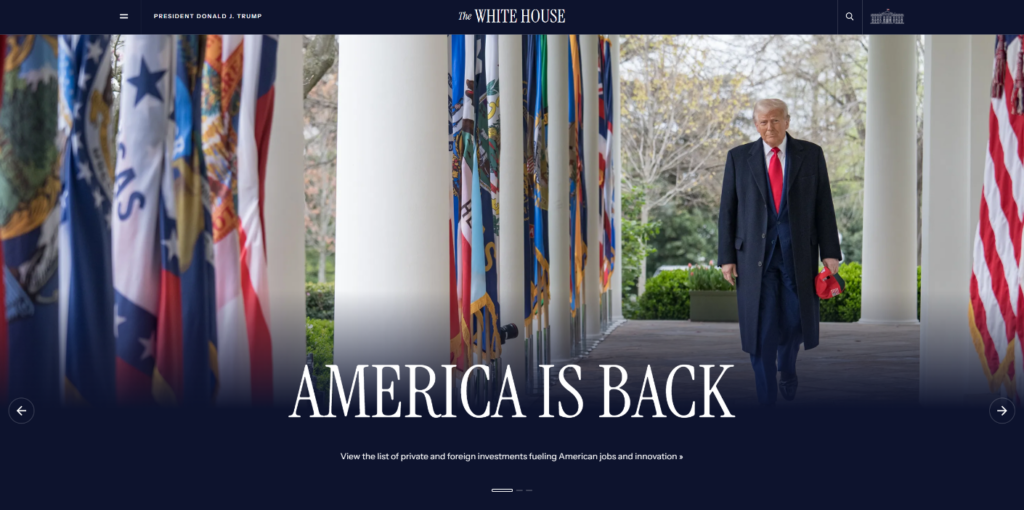
Recommended Civics and Law Guides
Books and websites can help you dive deeper:
- “How Our Laws Are Made” by the U.S. House of Representatives.
- Local library civics sections.
- Online courses in American government.
Conclusion
Recap of the How a Bill Becomes a Law Flowchart Benefits
We’ve walked through each stage of the legislative process, from a simple idea to an official law. Using a how a bill becomes a law flowchart makes this journey clearer, faster, and more engaging.
With tools like VisualGPT and its AI Flowchart Generator, you can create your own customized charts for classrooms, presentations, or personal learning.
Encouraging Civic Understanding Through Visuals
The more people understand how laws are made, the more they can participate in shaping them. Whether you’re teaching students, leading a workshop, or just curious, a good how a bill becomes a law flowchart is your ticket to turning confusion into clarity.


